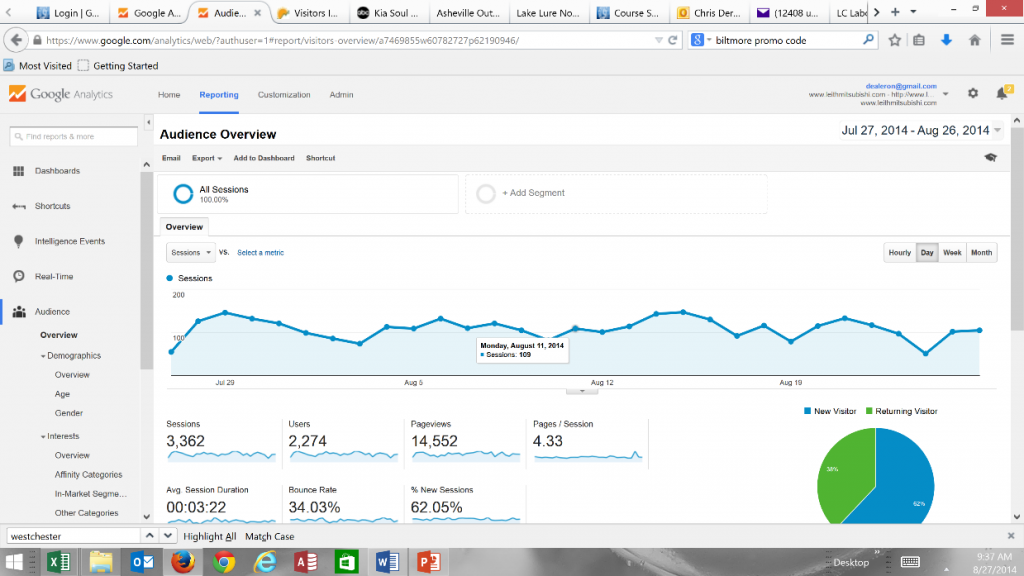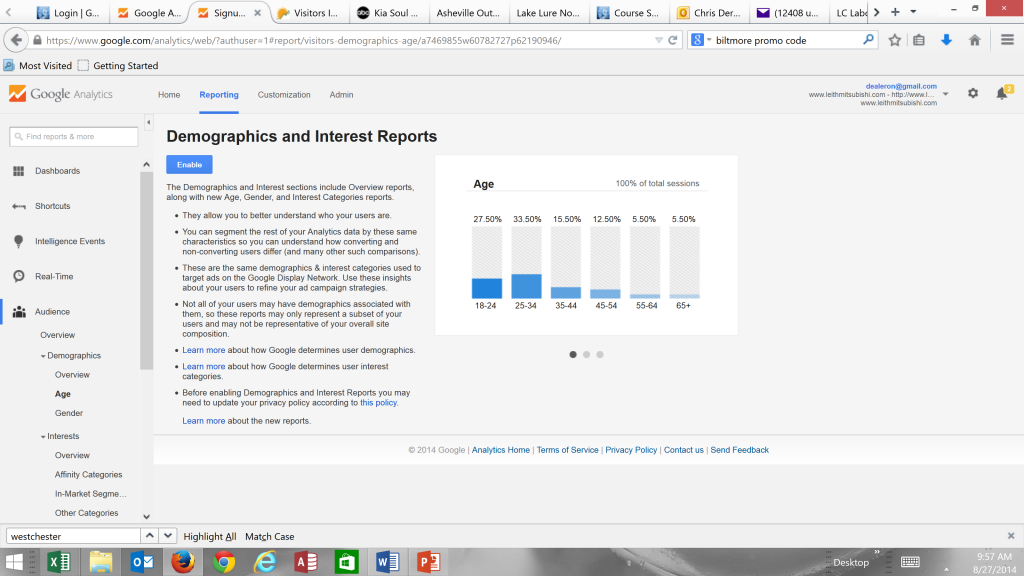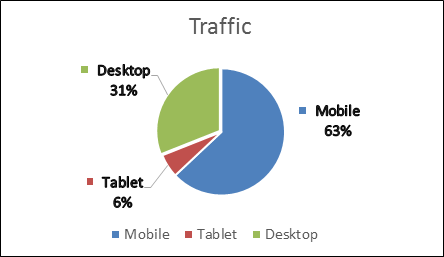DealerOn.com, the premier website and digital marketing provider for American car dealers announced the hiring of Pogo Parr as their new Vice President of Sales.
DealerOn, a premier car dealer website and digital marketing provider in the United States and Mitsubishi Motors North America, Inc. (MMNA) jointly announced that DealerOn has officially joined the Mitsubishi Diamond Digital Solutions (“DDS”) Website Program, becoming the fourth website provider in the program.

Almost every month Google provides some new, interesting, beneficial improvement to Google Analytics. In late 2013 Google began providing rich data about the demographics and interests of your website traffic. At DealerOn, we’re always trying to use data to improve the customer experience for our dealers, so I wanted to show you how to use Google Analytics Demographics information so you can learn more about your website visitors and understand how your site is serving them. The first step is to set up the Demographics reporting in Google Analytics.
Setting Up Demographics Data
When you log into Google Analytics, you will see a screen like this:

If you click on the text “Age” under the Audience>Demographics section, you will get the screen below. Click on the “Enable” button. You will get a message that says “Congratulations! You have successfully enabled the Demographics Reports. While you can access them now, it may take up to 24 hours before there is data available in these reports.”
In a few days or weeks you will have enough data to start analyzing the demographics of the traffic that is actually coming to your site. You’ll be able to see the:
1) the ages of the traffic coming to your site (18-24, 25-34, 35-44, 45-54, 55-64, 65+),
2) Sex (split of male/female)
3) Interests (Affinity Categories like Movie Lovers, Auto Enthusiasts)
4) In-Market Segments like Autos & Vehicles/Motor Vehicles/Motor Vehicles (Used)
There’s a treasure trove of information that you can take advantage of to improve your own marketing efforts as well as make sure that you’re delivering a great customer website experience. For today, I want to touch on Age and Device (mobile vs. tablet vs. desktop). In the past, my colleagues and I have talked about the importance of mobile and responsive websites, but when you break down demographics for a dealer’s website traffic, the importance of mobile and the younger demographics becomes stark. For one of our highest trafficked sites, here is the breakout of Mobile/Tablet/Desktop for 18-24 year olds:

For ages 25-34 and 35-44, Mobile is still higher than desktop, even without including Tablet traffic. Too many dealers are still assessing their websites based on browsing the site at the dealership on a computer. For many sites (you should check yours), the majority of traffic from your target demographic may not even be seeing that version of your site. If you’re a Kia dealer and your brand is targeting young professionals, then your mobile site experience is paramount to your digital brand. You should check to see whether the advertising that you’re doing is focused on younger demographics and that your site is delivering a good experience for them. We’ll explore other ways of using this demographics and interest information to make better marketing decisions over the next few weeks.

Let me know if you have any topics you’d specifically like us to cover on how to get the most out of your Google Analytics Demographic and Interest data.
If you’ve ever experienced birds chirping, singing, calling or screeching at night, you were probably annoyed by it. Today, businesses including your dealership must be aware of birds chirping into the early hours of the morning. The “birds” are the consumers of our modern, or some would say, post-modern era and they don’t always sing during business hours.
Twitter and Facebook offer us the opportunity to say whatever we want, whenever we want and that presents challenges for most dealers. Contrast the Twitter, Facebook and Instagram realm with how difficult it was to praise or shame a business in 1995. BIG difference. If you’re a little young to remember life at that time, it’s important to know that less that 5% of Americans were using the internet before 1995. Unlike today, where 87% of adults in the USA are on the internet and the percentage grows to almost 100% among those living in households earning $75,000 or more. BOOM!

You have a voice that can be amplified online more than any other time in human history, but… so does every single person that visits your website, sees your advertising efforts, calls your dealership, buys a car from you, services their car with you and so on…
What’s your social media strategy look like right now? Are you one of the many dealerships that have scaled back believing that the effort yields nothing in return? Many dealers started running the social media race primarily focused on capitalizing on a new way to sell cars. Unfortunately, none of us knew exactly how to approach the sales side of social media and totally missed the communication importance offered by social media. Yes, you can and should be selling some cars through social media, but you are unlikely to sell any if you aren’t watching, listening, engaging and answering when the birds start chirping.
One way to be sure you hear the birds is by using social media tools like Mention. Mention is specifically a listening tool that allows you to hear what’s being said about your business on the web. They recently released an infographic based on Twitter data they’ve assembled and crunched. Along with the data, they gathered opinions on the information from a handful of social media experts. I highly recommend checking it out.
Here are some takeaways:
- 271 million people are active on Twitter every month
- Some of them are talking to you, some of them are talking about you
- Almost 31% of tweets containing a company name do NOT include their twitter handle
- 60% of company mentions on Twitter are posted when you’re NOT in the office
If you’re looking for a simple way to make sure you never miss a thing. Check out Mention here and download their mobile app to make sure you always hear the birds chirping.
Until next time, may you find yourself and your business more attractive, attentive and aware.
#birdschirpatnight

Your dealership probably has at least one review portal that your marketing efforts are focused on…Google? Facebook? Yelp? DealerRater? Which portal works best for your car dealership? Is your focus in line with the portal your customers prefer to use?
Mike Blumenthals, a local search and Google Places expert, recently created a Google survey to find out where American adult Internet users prefer to leave reviews online. After filtering out the 77.8% of survey takers that self-reported that they never or almost never leave reviews, Blumenthals asked the following question:
When you leave a review online for a local business, which site are you most likely to use?
- Google – 32%
- Facebook – 20.6%
- Yelp – 17.5%
While the margin of error allows for Yelp and FB to be neck and neck, this does show a growth in the desire to leave reviews on Facebook, even though they aren’t necessarily known as a review aggregator.
So, while users prefer to leave their online reviews on Facebook, it’s unfortunate for small businesses like your dealership that Facebook doesn’t highlight business reviews, nor does it really promote them. In fact, it can be downright difficult to find the reviews on your dealership’s business page. What is your dealership to do?
First, continue to focus on Google reviews. They are still the clear leader, and provide the most bang for your marketing buck given their dominance in the search engine market. Having a healthy number of reviews consistently flowing into your Google+ Local page gives your dealership a better chance of a high ranking in Google’s search results.
But don’t sleep on Facebook Reviews. They are a smart company, and they will put more of a focus on business reviews in the future. Given that their platform has almost accidentally become the 2nd biggest consumer review site, it is just a matter of time before business reviews become a highlighted part of Facebook for businesses. Make sure your dealership is ahead of the curve. Spend some time and effort building positive reviews on Facebook, since many consumers are already looking at them, and the number is likely to grow dramatically over time.
As for Yelp, could the recent controversy surrounding the quality and validity of their reviews beginning to discourage consumers from leaving reviews there? If you have shied away from Yelp, one thing you should be aware of is that Google’s recent Pigeon change (which I wrote about last week) has given Yelp reviews MUCH more visibility in Google (see this article by Matt McGee). But, it may just be easier and smarter for the long term to focus on building your dealership’s review volumes on Google and Facebook, since there’s little question about their long-term consumer influence. Has your dealership seen an increase in Facebook reviews?

